Understanding Contemporary Organisations
VerifiedAdded on 2023/06/11
|9
|2835
|354
AI Summary
This report analyses the practices related to structure that is followed by the organisation and the way in which they do their people management. Along with this it also evaluates its marketing and financial practices. At last it describes the way in which Qantas reflects integration along with the way in which they interact as well as has impact on each other.
Contribute Materials
Your contribution can guide someone’s learning journey. Share your
documents today.
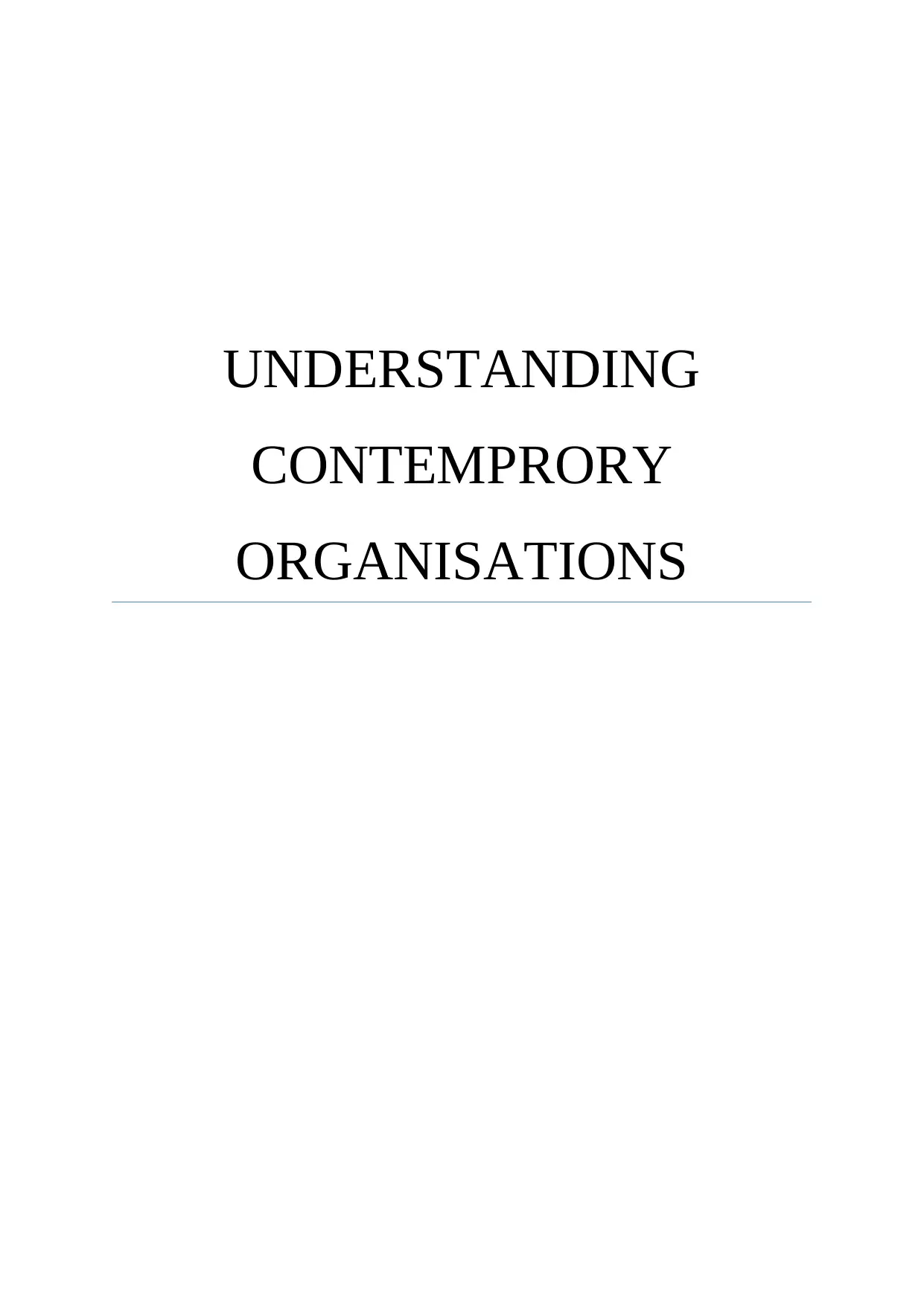
UNDERSTANDING
CONTEMPRORY
ORGANISATIONS
CONTEMPRORY
ORGANISATIONS
Secure Best Marks with AI Grader
Need help grading? Try our AI Grader for instant feedback on your assignments.
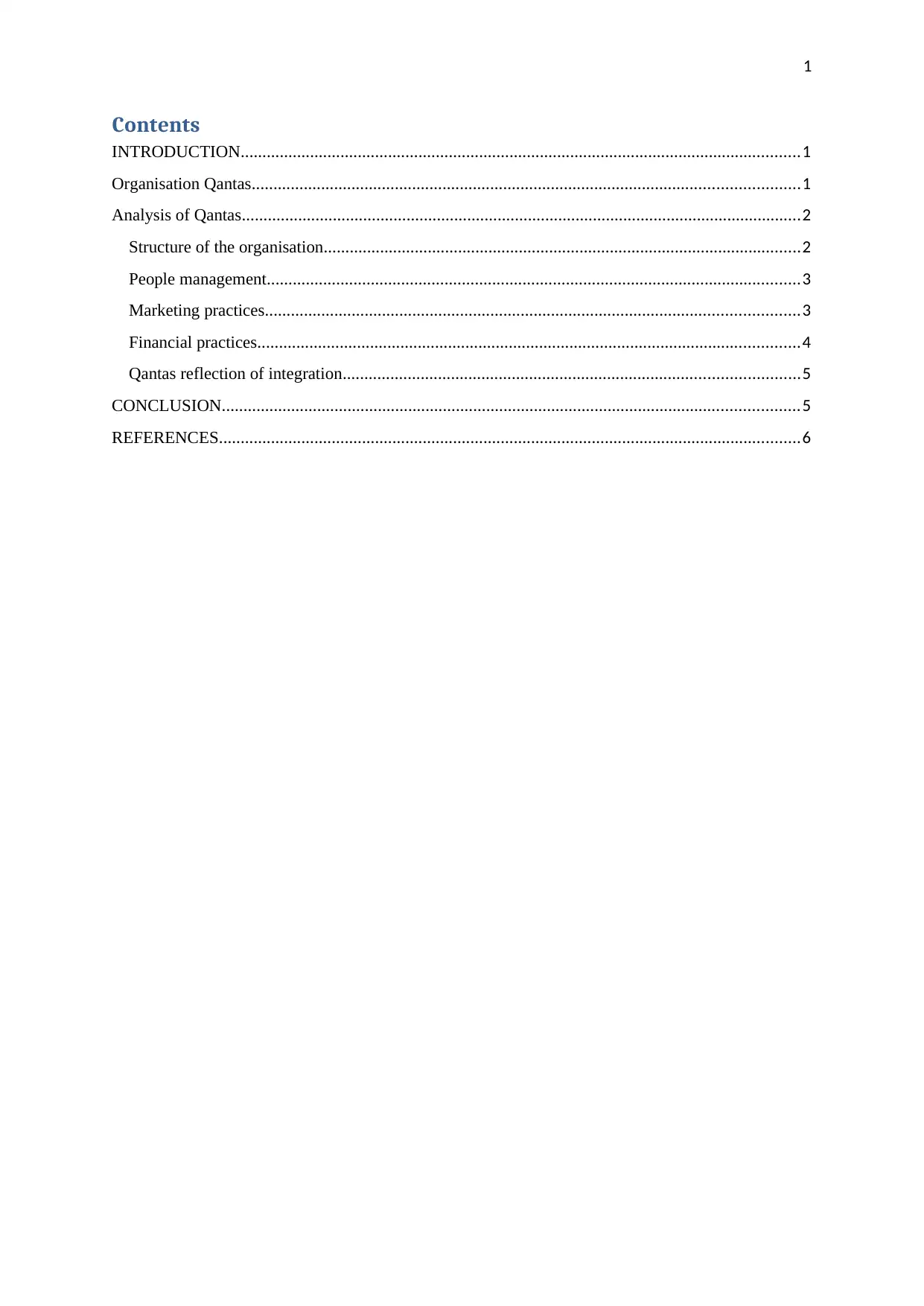
1
Contents
INTRODUCTION.................................................................................................................................1
Organisation Qantas..............................................................................................................................1
Analysis of Qantas.................................................................................................................................2
Structure of the organisation..............................................................................................................2
People management...........................................................................................................................3
Marketing practices...........................................................................................................................3
Financial practices.............................................................................................................................4
Qantas reflection of integration.........................................................................................................5
CONCLUSION.....................................................................................................................................5
REFERENCES......................................................................................................................................6
Contents
INTRODUCTION.................................................................................................................................1
Organisation Qantas..............................................................................................................................1
Analysis of Qantas.................................................................................................................................2
Structure of the organisation..............................................................................................................2
People management...........................................................................................................................3
Marketing practices...........................................................................................................................3
Financial practices.............................................................................................................................4
Qantas reflection of integration.........................................................................................................5
CONCLUSION.....................................................................................................................................5
REFERENCES......................................................................................................................................6
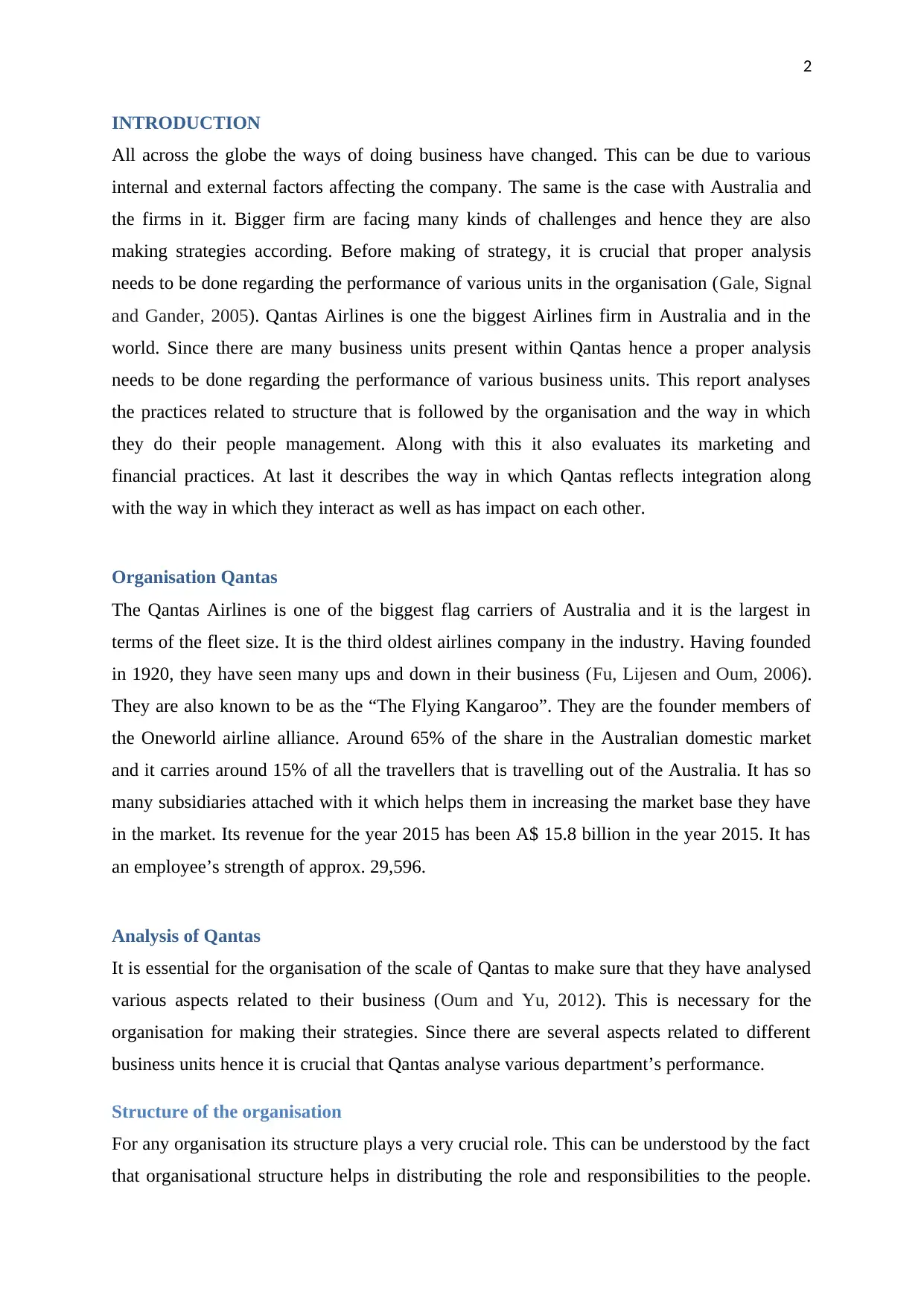
2
INTRODUCTION
All across the globe the ways of doing business have changed. This can be due to various
internal and external factors affecting the company. The same is the case with Australia and
the firms in it. Bigger firm are facing many kinds of challenges and hence they are also
making strategies according. Before making of strategy, it is crucial that proper analysis
needs to be done regarding the performance of various units in the organisation (Gale, Signal
and Gander, 2005). Qantas Airlines is one the biggest Airlines firm in Australia and in the
world. Since there are many business units present within Qantas hence a proper analysis
needs to be done regarding the performance of various business units. This report analyses
the practices related to structure that is followed by the organisation and the way in which
they do their people management. Along with this it also evaluates its marketing and
financial practices. At last it describes the way in which Qantas reflects integration along
with the way in which they interact as well as has impact on each other.
Organisation Qantas
The Qantas Airlines is one of the biggest flag carriers of Australia and it is the largest in
terms of the fleet size. It is the third oldest airlines company in the industry. Having founded
in 1920, they have seen many ups and down in their business (Fu, Lijesen and Oum, 2006).
They are also known to be as the “The Flying Kangaroo”. They are the founder members of
the Oneworld airline alliance. Around 65% of the share in the Australian domestic market
and it carries around 15% of all the travellers that is travelling out of the Australia. It has so
many subsidiaries attached with it which helps them in increasing the market base they have
in the market. Its revenue for the year 2015 has been A$ 15.8 billion in the year 2015. It has
an employee’s strength of approx. 29,596.
Analysis of Qantas
It is essential for the organisation of the scale of Qantas to make sure that they have analysed
various aspects related to their business (Oum and Yu, 2012). This is necessary for the
organisation for making their strategies. Since there are several aspects related to different
business units hence it is crucial that Qantas analyse various department’s performance.
Structure of the organisation
For any organisation its structure plays a very crucial role. This can be understood by the fact
that organisational structure helps in distributing the role and responsibilities to the people.
INTRODUCTION
All across the globe the ways of doing business have changed. This can be due to various
internal and external factors affecting the company. The same is the case with Australia and
the firms in it. Bigger firm are facing many kinds of challenges and hence they are also
making strategies according. Before making of strategy, it is crucial that proper analysis
needs to be done regarding the performance of various units in the organisation (Gale, Signal
and Gander, 2005). Qantas Airlines is one the biggest Airlines firm in Australia and in the
world. Since there are many business units present within Qantas hence a proper analysis
needs to be done regarding the performance of various business units. This report analyses
the practices related to structure that is followed by the organisation and the way in which
they do their people management. Along with this it also evaluates its marketing and
financial practices. At last it describes the way in which Qantas reflects integration along
with the way in which they interact as well as has impact on each other.
Organisation Qantas
The Qantas Airlines is one of the biggest flag carriers of Australia and it is the largest in
terms of the fleet size. It is the third oldest airlines company in the industry. Having founded
in 1920, they have seen many ups and down in their business (Fu, Lijesen and Oum, 2006).
They are also known to be as the “The Flying Kangaroo”. They are the founder members of
the Oneworld airline alliance. Around 65% of the share in the Australian domestic market
and it carries around 15% of all the travellers that is travelling out of the Australia. It has so
many subsidiaries attached with it which helps them in increasing the market base they have
in the market. Its revenue for the year 2015 has been A$ 15.8 billion in the year 2015. It has
an employee’s strength of approx. 29,596.
Analysis of Qantas
It is essential for the organisation of the scale of Qantas to make sure that they have analysed
various aspects related to their business (Oum and Yu, 2012). This is necessary for the
organisation for making their strategies. Since there are several aspects related to different
business units hence it is crucial that Qantas analyse various department’s performance.
Structure of the organisation
For any organisation its structure plays a very crucial role. This can be understood by the fact
that organisational structure helps in distributing the role and responsibilities to the people.
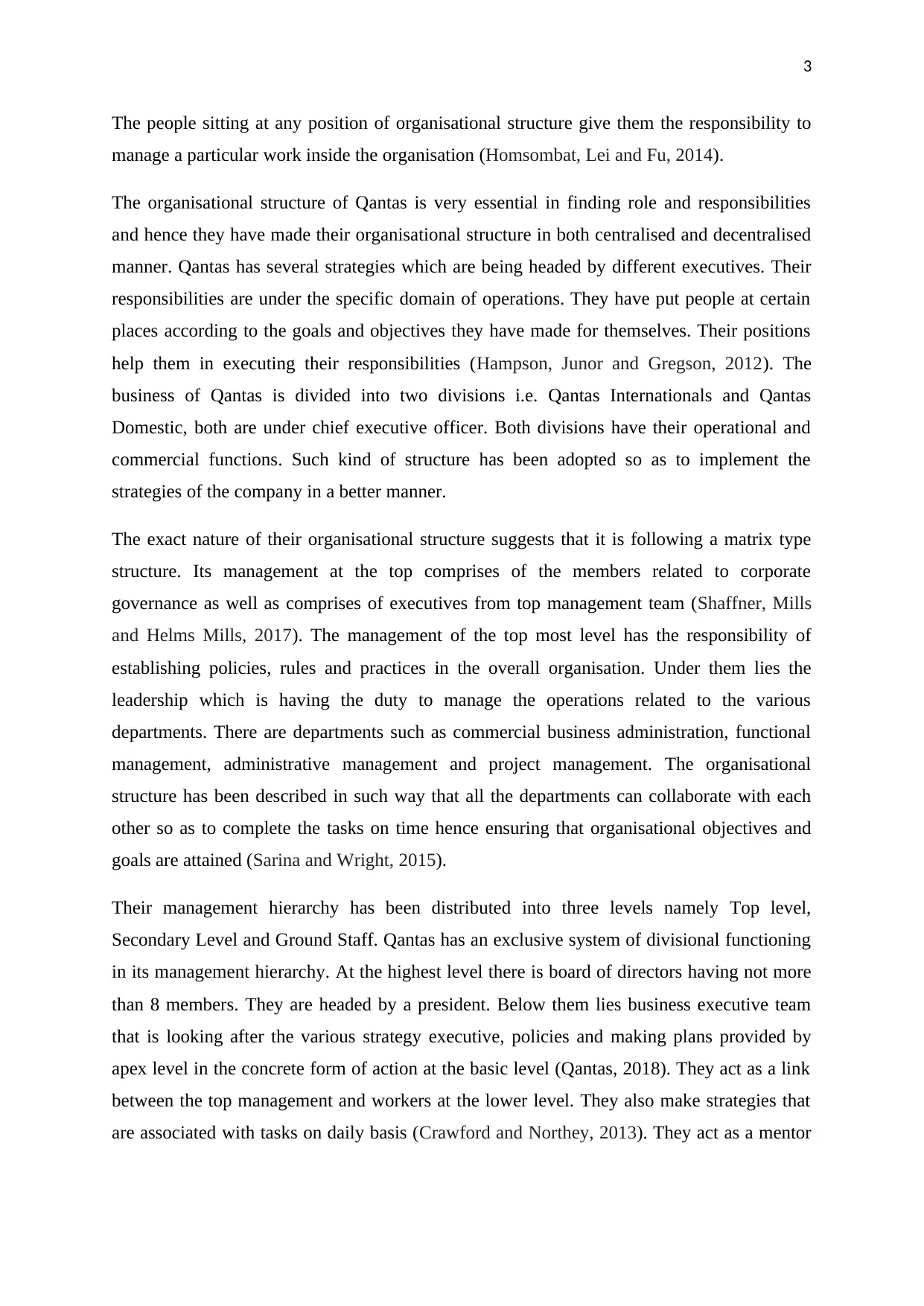
3
The people sitting at any position of organisational structure give them the responsibility to
manage a particular work inside the organisation (Homsombat, Lei and Fu, 2014).
The organisational structure of Qantas is very essential in finding role and responsibilities
and hence they have made their organisational structure in both centralised and decentralised
manner. Qantas has several strategies which are being headed by different executives. Their
responsibilities are under the specific domain of operations. They have put people at certain
places according to the goals and objectives they have made for themselves. Their positions
help them in executing their responsibilities (Hampson, Junor and Gregson, 2012). The
business of Qantas is divided into two divisions i.e. Qantas Internationals and Qantas
Domestic, both are under chief executive officer. Both divisions have their operational and
commercial functions. Such kind of structure has been adopted so as to implement the
strategies of the company in a better manner.
The exact nature of their organisational structure suggests that it is following a matrix type
structure. Its management at the top comprises of the members related to corporate
governance as well as comprises of executives from top management team (Shaffner, Mills
and Helms Mills, 2017). The management of the top most level has the responsibility of
establishing policies, rules and practices in the overall organisation. Under them lies the
leadership which is having the duty to manage the operations related to the various
departments. There are departments such as commercial business administration, functional
management, administrative management and project management. The organisational
structure has been described in such way that all the departments can collaborate with each
other so as to complete the tasks on time hence ensuring that organisational objectives and
goals are attained (Sarina and Wright, 2015).
Their management hierarchy has been distributed into three levels namely Top level,
Secondary Level and Ground Staff. Qantas has an exclusive system of divisional functioning
in its management hierarchy. At the highest level there is board of directors having not more
than 8 members. They are headed by a president. Below them lies business executive team
that is looking after the various strategy executive, policies and making plans provided by
apex level in the concrete form of action at the basic level (Qantas, 2018). They act as a link
between the top management and workers at the lower level. They also make strategies that
are associated with tasks on daily basis (Crawford and Northey, 2013). They act as a mentor
The people sitting at any position of organisational structure give them the responsibility to
manage a particular work inside the organisation (Homsombat, Lei and Fu, 2014).
The organisational structure of Qantas is very essential in finding role and responsibilities
and hence they have made their organisational structure in both centralised and decentralised
manner. Qantas has several strategies which are being headed by different executives. Their
responsibilities are under the specific domain of operations. They have put people at certain
places according to the goals and objectives they have made for themselves. Their positions
help them in executing their responsibilities (Hampson, Junor and Gregson, 2012). The
business of Qantas is divided into two divisions i.e. Qantas Internationals and Qantas
Domestic, both are under chief executive officer. Both divisions have their operational and
commercial functions. Such kind of structure has been adopted so as to implement the
strategies of the company in a better manner.
The exact nature of their organisational structure suggests that it is following a matrix type
structure. Its management at the top comprises of the members related to corporate
governance as well as comprises of executives from top management team (Shaffner, Mills
and Helms Mills, 2017). The management of the top most level has the responsibility of
establishing policies, rules and practices in the overall organisation. Under them lies the
leadership which is having the duty to manage the operations related to the various
departments. There are departments such as commercial business administration, functional
management, administrative management and project management. The organisational
structure has been described in such way that all the departments can collaborate with each
other so as to complete the tasks on time hence ensuring that organisational objectives and
goals are attained (Sarina and Wright, 2015).
Their management hierarchy has been distributed into three levels namely Top level,
Secondary Level and Ground Staff. Qantas has an exclusive system of divisional functioning
in its management hierarchy. At the highest level there is board of directors having not more
than 8 members. They are headed by a president. Below them lies business executive team
that is looking after the various strategy executive, policies and making plans provided by
apex level in the concrete form of action at the basic level (Qantas, 2018). They act as a link
between the top management and workers at the lower level. They also make strategies that
are associated with tasks on daily basis (Crawford and Northey, 2013). They act as a mentor
Secure Best Marks with AI Grader
Need help grading? Try our AI Grader for instant feedback on your assignments.
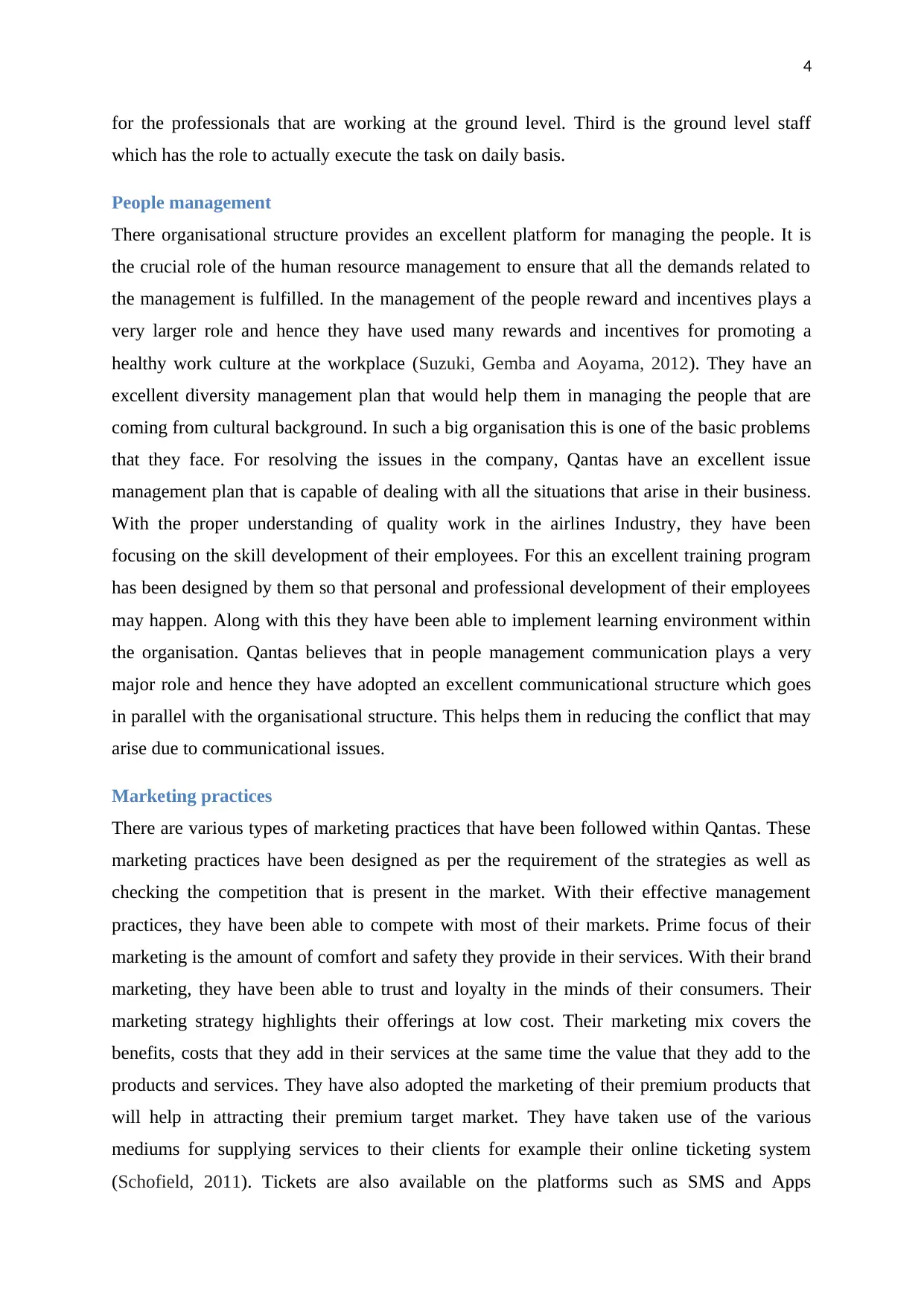
4
for the professionals that are working at the ground level. Third is the ground level staff
which has the role to actually execute the task on daily basis.
People management
There organisational structure provides an excellent platform for managing the people. It is
the crucial role of the human resource management to ensure that all the demands related to
the management is fulfilled. In the management of the people reward and incentives plays a
very larger role and hence they have used many rewards and incentives for promoting a
healthy work culture at the workplace (Suzuki, Gemba and Aoyama, 2012). They have an
excellent diversity management plan that would help them in managing the people that are
coming from cultural background. In such a big organisation this is one of the basic problems
that they face. For resolving the issues in the company, Qantas have an excellent issue
management plan that is capable of dealing with all the situations that arise in their business.
With the proper understanding of quality work in the airlines Industry, they have been
focusing on the skill development of their employees. For this an excellent training program
has been designed by them so that personal and professional development of their employees
may happen. Along with this they have been able to implement learning environment within
the organisation. Qantas believes that in people management communication plays a very
major role and hence they have adopted an excellent communicational structure which goes
in parallel with the organisational structure. This helps them in reducing the conflict that may
arise due to communicational issues.
Marketing practices
There are various types of marketing practices that have been followed within Qantas. These
marketing practices have been designed as per the requirement of the strategies as well as
checking the competition that is present in the market. With their effective management
practices, they have been able to compete with most of their markets. Prime focus of their
marketing is the amount of comfort and safety they provide in their services. With their brand
marketing, they have been able to trust and loyalty in the minds of their consumers. Their
marketing strategy highlights their offerings at low cost. Their marketing mix covers the
benefits, costs that they add in their services at the same time the value that they add to the
products and services. They have also adopted the marketing of their premium products that
will help in attracting their premium target market. They have taken use of the various
mediums for supplying services to their clients for example their online ticketing system
(Schofield, 2011). Tickets are also available on the platforms such as SMS and Apps
for the professionals that are working at the ground level. Third is the ground level staff
which has the role to actually execute the task on daily basis.
People management
There organisational structure provides an excellent platform for managing the people. It is
the crucial role of the human resource management to ensure that all the demands related to
the management is fulfilled. In the management of the people reward and incentives plays a
very larger role and hence they have used many rewards and incentives for promoting a
healthy work culture at the workplace (Suzuki, Gemba and Aoyama, 2012). They have an
excellent diversity management plan that would help them in managing the people that are
coming from cultural background. In such a big organisation this is one of the basic problems
that they face. For resolving the issues in the company, Qantas have an excellent issue
management plan that is capable of dealing with all the situations that arise in their business.
With the proper understanding of quality work in the airlines Industry, they have been
focusing on the skill development of their employees. For this an excellent training program
has been designed by them so that personal and professional development of their employees
may happen. Along with this they have been able to implement learning environment within
the organisation. Qantas believes that in people management communication plays a very
major role and hence they have adopted an excellent communicational structure which goes
in parallel with the organisational structure. This helps them in reducing the conflict that may
arise due to communicational issues.
Marketing practices
There are various types of marketing practices that have been followed within Qantas. These
marketing practices have been designed as per the requirement of the strategies as well as
checking the competition that is present in the market. With their effective management
practices, they have been able to compete with most of their markets. Prime focus of their
marketing is the amount of comfort and safety they provide in their services. With their brand
marketing, they have been able to trust and loyalty in the minds of their consumers. Their
marketing strategy highlights their offerings at low cost. Their marketing mix covers the
benefits, costs that they add in their services at the same time the value that they add to the
products and services. They have also adopted the marketing of their premium products that
will help in attracting their premium target market. They have taken use of the various
mediums for supplying services to their clients for example their online ticketing system
(Schofield, 2011). Tickets are also available on the platforms such as SMS and Apps
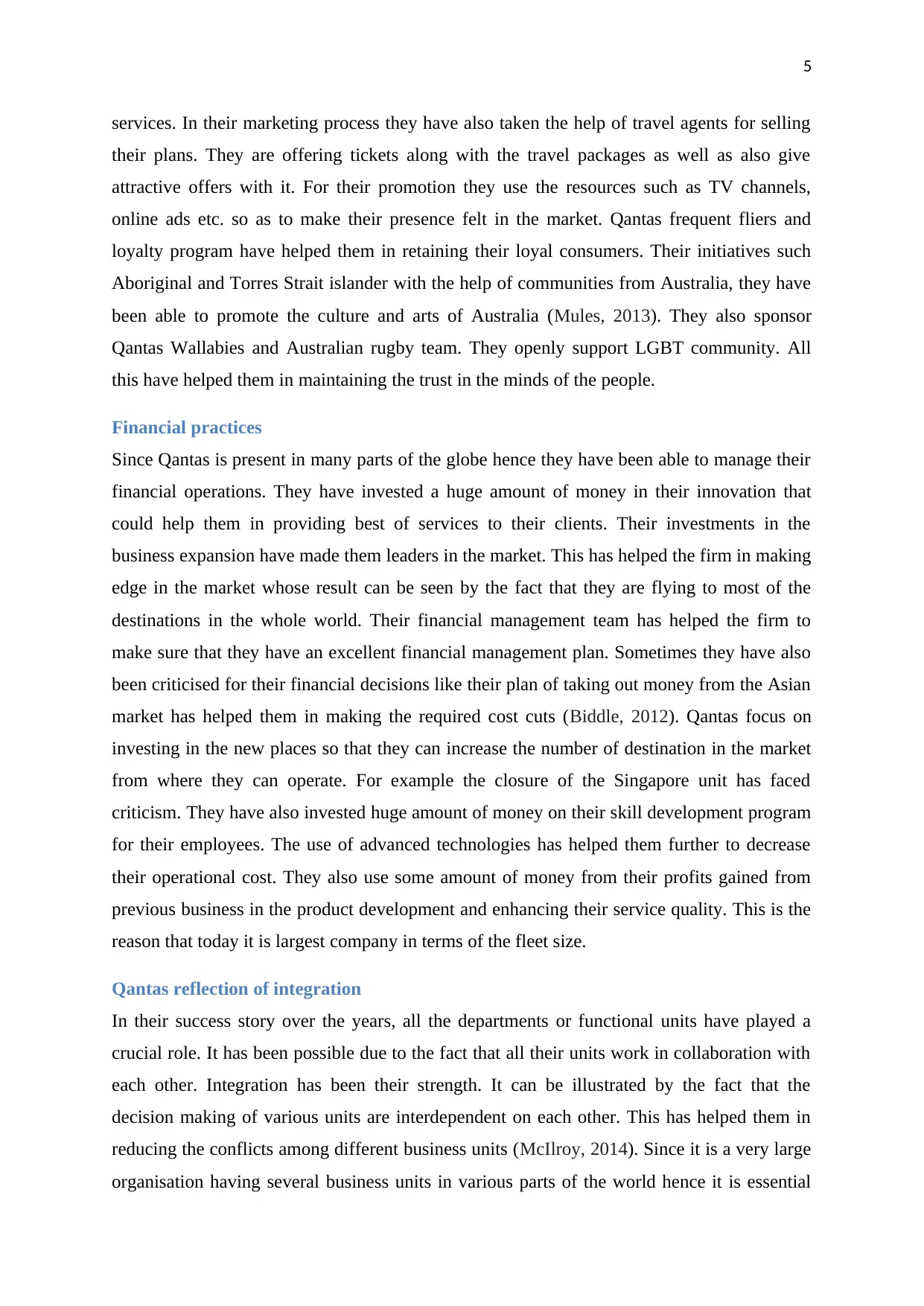
5
services. In their marketing process they have also taken the help of travel agents for selling
their plans. They are offering tickets along with the travel packages as well as also give
attractive offers with it. For their promotion they use the resources such as TV channels,
online ads etc. so as to make their presence felt in the market. Qantas frequent fliers and
loyalty program have helped them in retaining their loyal consumers. Their initiatives such
Aboriginal and Torres Strait islander with the help of communities from Australia, they have
been able to promote the culture and arts of Australia (Mules, 2013). They also sponsor
Qantas Wallabies and Australian rugby team. They openly support LGBT community. All
this have helped them in maintaining the trust in the minds of the people.
Financial practices
Since Qantas is present in many parts of the globe hence they have been able to manage their
financial operations. They have invested a huge amount of money in their innovation that
could help them in providing best of services to their clients. Their investments in the
business expansion have made them leaders in the market. This has helped the firm in making
edge in the market whose result can be seen by the fact that they are flying to most of the
destinations in the whole world. Their financial management team has helped the firm to
make sure that they have an excellent financial management plan. Sometimes they have also
been criticised for their financial decisions like their plan of taking out money from the Asian
market has helped them in making the required cost cuts (Biddle, 2012). Qantas focus on
investing in the new places so that they can increase the number of destination in the market
from where they can operate. For example the closure of the Singapore unit has faced
criticism. They have also invested huge amount of money on their skill development program
for their employees. The use of advanced technologies has helped them further to decrease
their operational cost. They also use some amount of money from their profits gained from
previous business in the product development and enhancing their service quality. This is the
reason that today it is largest company in terms of the fleet size.
Qantas reflection of integration
In their success story over the years, all the departments or functional units have played a
crucial role. It has been possible due to the fact that all their units work in collaboration with
each other. Integration has been their strength. It can be illustrated by the fact that the
decision making of various units are interdependent on each other. This has helped them in
reducing the conflicts among different business units (McIlroy, 2014). Since it is a very large
organisation having several business units in various parts of the world hence it is essential
services. In their marketing process they have also taken the help of travel agents for selling
their plans. They are offering tickets along with the travel packages as well as also give
attractive offers with it. For their promotion they use the resources such as TV channels,
online ads etc. so as to make their presence felt in the market. Qantas frequent fliers and
loyalty program have helped them in retaining their loyal consumers. Their initiatives such
Aboriginal and Torres Strait islander with the help of communities from Australia, they have
been able to promote the culture and arts of Australia (Mules, 2013). They also sponsor
Qantas Wallabies and Australian rugby team. They openly support LGBT community. All
this have helped them in maintaining the trust in the minds of the people.
Financial practices
Since Qantas is present in many parts of the globe hence they have been able to manage their
financial operations. They have invested a huge amount of money in their innovation that
could help them in providing best of services to their clients. Their investments in the
business expansion have made them leaders in the market. This has helped the firm in making
edge in the market whose result can be seen by the fact that they are flying to most of the
destinations in the whole world. Their financial management team has helped the firm to
make sure that they have an excellent financial management plan. Sometimes they have also
been criticised for their financial decisions like their plan of taking out money from the Asian
market has helped them in making the required cost cuts (Biddle, 2012). Qantas focus on
investing in the new places so that they can increase the number of destination in the market
from where they can operate. For example the closure of the Singapore unit has faced
criticism. They have also invested huge amount of money on their skill development program
for their employees. The use of advanced technologies has helped them further to decrease
their operational cost. They also use some amount of money from their profits gained from
previous business in the product development and enhancing their service quality. This is the
reason that today it is largest company in terms of the fleet size.
Qantas reflection of integration
In their success story over the years, all the departments or functional units have played a
crucial role. It has been possible due to the fact that all their units work in collaboration with
each other. Integration has been their strength. It can be illustrated by the fact that the
decision making of various units are interdependent on each other. This has helped them in
reducing the conflicts among different business units (McIlroy, 2014). Since it is a very large
organisation having several business units in various parts of the world hence it is essential
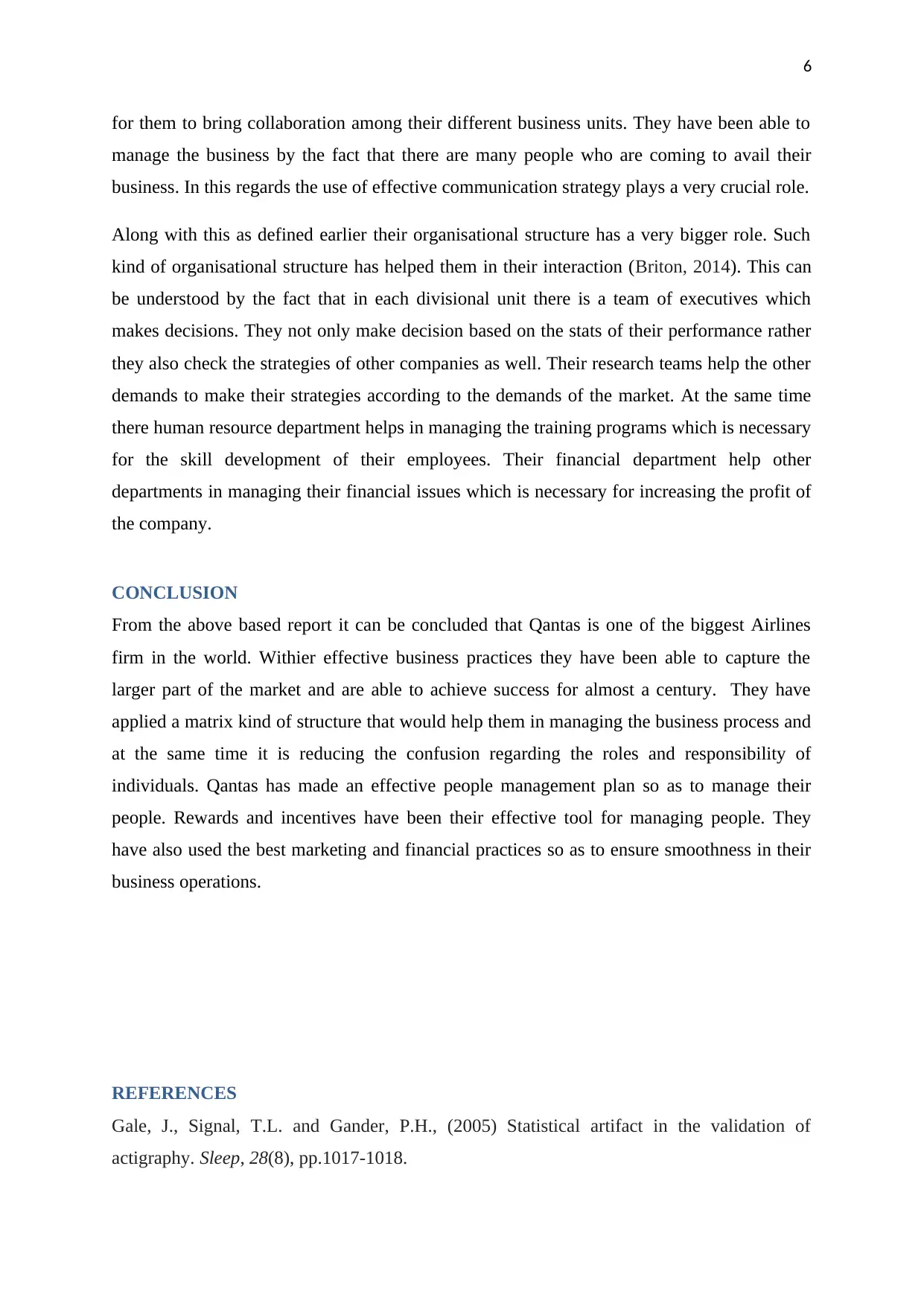
6
for them to bring collaboration among their different business units. They have been able to
manage the business by the fact that there are many people who are coming to avail their
business. In this regards the use of effective communication strategy plays a very crucial role.
Along with this as defined earlier their organisational structure has a very bigger role. Such
kind of organisational structure has helped them in their interaction (Briton, 2014). This can
be understood by the fact that in each divisional unit there is a team of executives which
makes decisions. They not only make decision based on the stats of their performance rather
they also check the strategies of other companies as well. Their research teams help the other
demands to make their strategies according to the demands of the market. At the same time
there human resource department helps in managing the training programs which is necessary
for the skill development of their employees. Their financial department help other
departments in managing their financial issues which is necessary for increasing the profit of
the company.
CONCLUSION
From the above based report it can be concluded that Qantas is one of the biggest Airlines
firm in the world. Withier effective business practices they have been able to capture the
larger part of the market and are able to achieve success for almost a century. They have
applied a matrix kind of structure that would help them in managing the business process and
at the same time it is reducing the confusion regarding the roles and responsibility of
individuals. Qantas has made an effective people management plan so as to manage their
people. Rewards and incentives have been their effective tool for managing people. They
have also used the best marketing and financial practices so as to ensure smoothness in their
business operations.
REFERENCES
Gale, J., Signal, T.L. and Gander, P.H., (2005) Statistical artifact in the validation of
actigraphy. Sleep, 28(8), pp.1017-1018.
for them to bring collaboration among their different business units. They have been able to
manage the business by the fact that there are many people who are coming to avail their
business. In this regards the use of effective communication strategy plays a very crucial role.
Along with this as defined earlier their organisational structure has a very bigger role. Such
kind of organisational structure has helped them in their interaction (Briton, 2014). This can
be understood by the fact that in each divisional unit there is a team of executives which
makes decisions. They not only make decision based on the stats of their performance rather
they also check the strategies of other companies as well. Their research teams help the other
demands to make their strategies according to the demands of the market. At the same time
there human resource department helps in managing the training programs which is necessary
for the skill development of their employees. Their financial department help other
departments in managing their financial issues which is necessary for increasing the profit of
the company.
CONCLUSION
From the above based report it can be concluded that Qantas is one of the biggest Airlines
firm in the world. Withier effective business practices they have been able to capture the
larger part of the market and are able to achieve success for almost a century. They have
applied a matrix kind of structure that would help them in managing the business process and
at the same time it is reducing the confusion regarding the roles and responsibility of
individuals. Qantas has made an effective people management plan so as to manage their
people. Rewards and incentives have been their effective tool for managing people. They
have also used the best marketing and financial practices so as to ensure smoothness in their
business operations.
REFERENCES
Gale, J., Signal, T.L. and Gander, P.H., (2005) Statistical artifact in the validation of
actigraphy. Sleep, 28(8), pp.1017-1018.
Paraphrase This Document
Need a fresh take? Get an instant paraphrase of this document with our AI Paraphraser
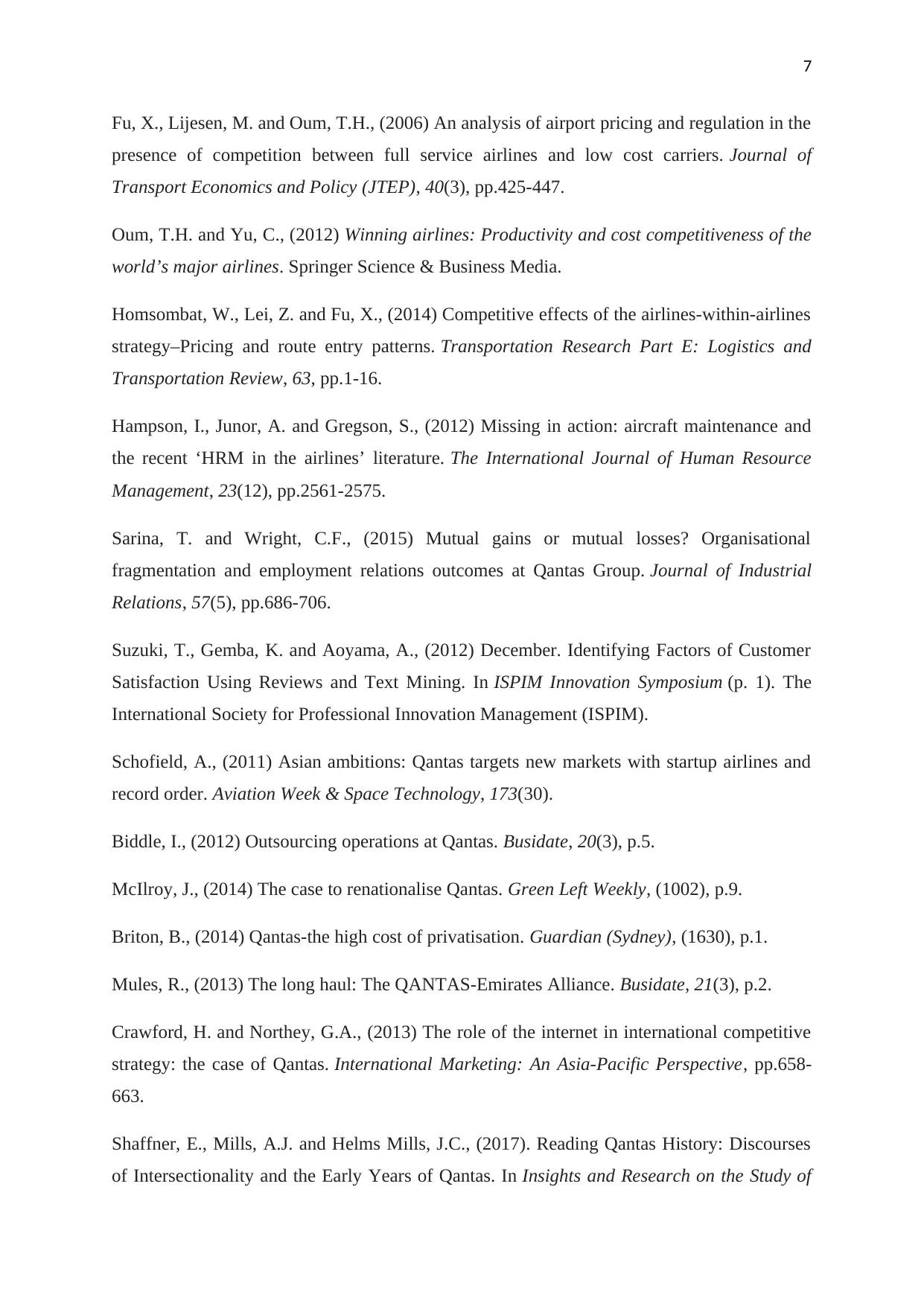
7
Fu, X., Lijesen, M. and Oum, T.H., (2006) An analysis of airport pricing and regulation in the
presence of competition between full service airlines and low cost carriers. Journal of
Transport Economics and Policy (JTEP), 40(3), pp.425-447.
Oum, T.H. and Yu, C., (2012) Winning airlines: Productivity and cost competitiveness of the
world’s major airlines. Springer Science & Business Media.
Homsombat, W., Lei, Z. and Fu, X., (2014) Competitive effects of the airlines-within-airlines
strategy–Pricing and route entry patterns. Transportation Research Part E: Logistics and
Transportation Review, 63, pp.1-16.
Hampson, I., Junor, A. and Gregson, S., (2012) Missing in action: aircraft maintenance and
the recent ‘HRM in the airlines’ literature. The International Journal of Human Resource
Management, 23(12), pp.2561-2575.
Sarina, T. and Wright, C.F., (2015) Mutual gains or mutual losses? Organisational
fragmentation and employment relations outcomes at Qantas Group. Journal of Industrial
Relations, 57(5), pp.686-706.
Suzuki, T., Gemba, K. and Aoyama, A., (2012) December. Identifying Factors of Customer
Satisfaction Using Reviews and Text Mining. In ISPIM Innovation Symposium (p. 1). The
International Society for Professional Innovation Management (ISPIM).
Schofield, A., (2011) Asian ambitions: Qantas targets new markets with startup airlines and
record order. Aviation Week & Space Technology, 173(30).
Biddle, I., (2012) Outsourcing operations at Qantas. Busidate, 20(3), p.5.
McIlroy, J., (2014) The case to renationalise Qantas. Green Left Weekly, (1002), p.9.
Briton, B., (2014) Qantas-the high cost of privatisation. Guardian (Sydney), (1630), p.1.
Mules, R., (2013) The long haul: The QANTAS-Emirates Alliance. Busidate, 21(3), p.2.
Crawford, H. and Northey, G.A., (2013) The role of the internet in international competitive
strategy: the case of Qantas. International Marketing: An Asia-Pacific Perspective, pp.658-
663.
Shaffner, E., Mills, A.J. and Helms Mills, J.C., (2017). Reading Qantas History: Discourses
of Intersectionality and the Early Years of Qantas. In Insights and Research on the Study of
Fu, X., Lijesen, M. and Oum, T.H., (2006) An analysis of airport pricing and regulation in the
presence of competition between full service airlines and low cost carriers. Journal of
Transport Economics and Policy (JTEP), 40(3), pp.425-447.
Oum, T.H. and Yu, C., (2012) Winning airlines: Productivity and cost competitiveness of the
world’s major airlines. Springer Science & Business Media.
Homsombat, W., Lei, Z. and Fu, X., (2014) Competitive effects of the airlines-within-airlines
strategy–Pricing and route entry patterns. Transportation Research Part E: Logistics and
Transportation Review, 63, pp.1-16.
Hampson, I., Junor, A. and Gregson, S., (2012) Missing in action: aircraft maintenance and
the recent ‘HRM in the airlines’ literature. The International Journal of Human Resource
Management, 23(12), pp.2561-2575.
Sarina, T. and Wright, C.F., (2015) Mutual gains or mutual losses? Organisational
fragmentation and employment relations outcomes at Qantas Group. Journal of Industrial
Relations, 57(5), pp.686-706.
Suzuki, T., Gemba, K. and Aoyama, A., (2012) December. Identifying Factors of Customer
Satisfaction Using Reviews and Text Mining. In ISPIM Innovation Symposium (p. 1). The
International Society for Professional Innovation Management (ISPIM).
Schofield, A., (2011) Asian ambitions: Qantas targets new markets with startup airlines and
record order. Aviation Week & Space Technology, 173(30).
Biddle, I., (2012) Outsourcing operations at Qantas. Busidate, 20(3), p.5.
McIlroy, J., (2014) The case to renationalise Qantas. Green Left Weekly, (1002), p.9.
Briton, B., (2014) Qantas-the high cost of privatisation. Guardian (Sydney), (1630), p.1.
Mules, R., (2013) The long haul: The QANTAS-Emirates Alliance. Busidate, 21(3), p.2.
Crawford, H. and Northey, G.A., (2013) The role of the internet in international competitive
strategy: the case of Qantas. International Marketing: An Asia-Pacific Perspective, pp.658-
663.
Shaffner, E., Mills, A.J. and Helms Mills, J.C., (2017). Reading Qantas History: Discourses
of Intersectionality and the Early Years of Qantas. In Insights and Research on the Study of
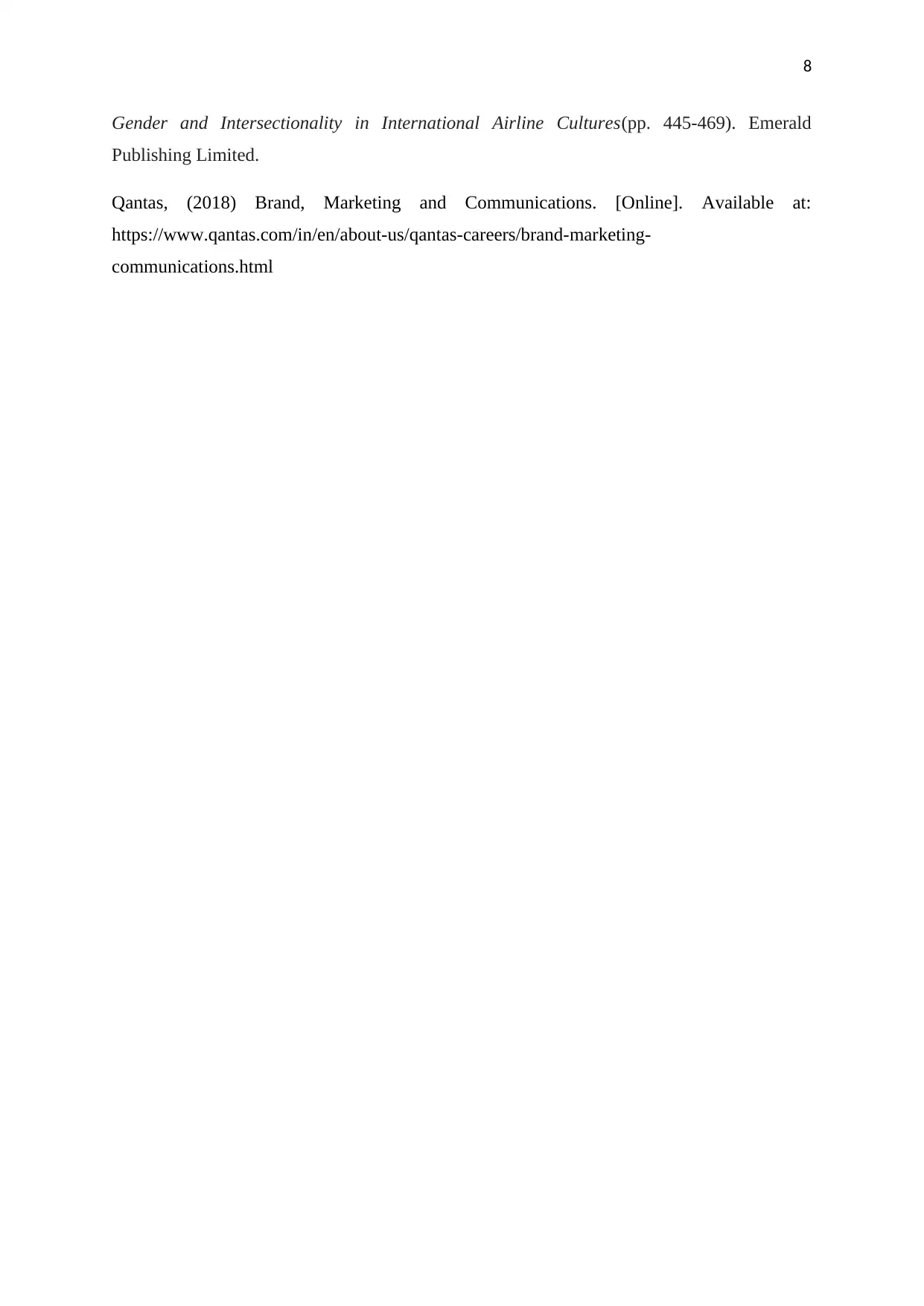
8
Gender and Intersectionality in International Airline Cultures(pp. 445-469). Emerald
Publishing Limited.
Qantas, (2018) Brand, Marketing and Communications. [Online]. Available at:
https://www.qantas.com/in/en/about-us/qantas-careers/brand-marketing-
communications.html
Gender and Intersectionality in International Airline Cultures(pp. 445-469). Emerald
Publishing Limited.
Qantas, (2018) Brand, Marketing and Communications. [Online]. Available at:
https://www.qantas.com/in/en/about-us/qantas-careers/brand-marketing-
communications.html
1 out of 9
Related Documents
Your All-in-One AI-Powered Toolkit for Academic Success.
+13062052269
info@desklib.com
Available 24*7 on WhatsApp / Email
![[object Object]](/_next/static/media/star-bottom.7253800d.svg)
Unlock your academic potential
© 2024 | Zucol Services PVT LTD | All rights reserved.





